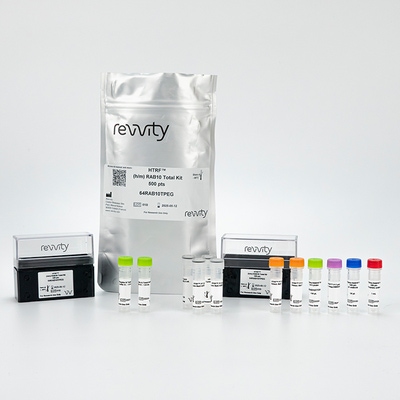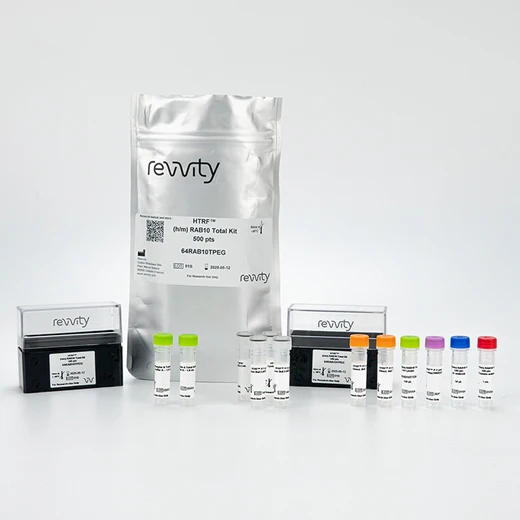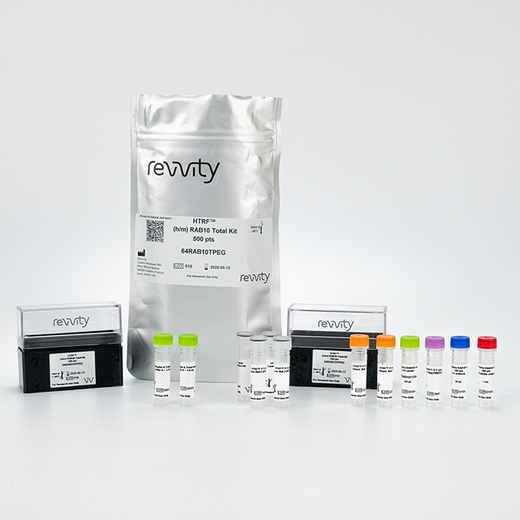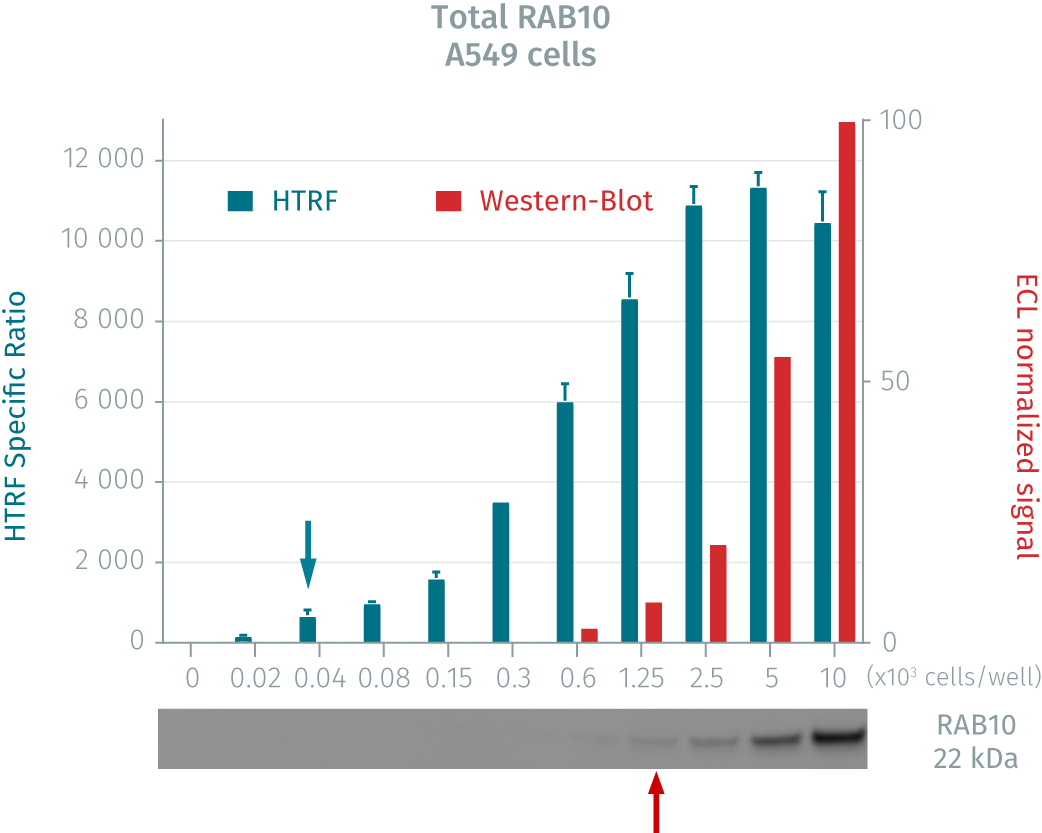

HTRF Human and Mouse Total RAB10 Detection Kit, 10,000 Assay Points


HTRF Human and Mouse Total RAB10 Detection Kit, 10,000 Assay Points






The HTRF total RAB10 kit is designed to monitor the expression level of cellular RAB10, a RAB GTPase that regulates intracellular membrane trafficking. This kit can be used as a normalization assay with our Phospho-RAB10 Thr73 kit.
| Feature | Specification |
|---|---|
| Application | Cell Signaling |
| Sample Volume | 16 µL |
The HTRF total RAB10 kit is designed to monitor the expression level of cellular RAB10, a RAB GTPase that regulates intracellular membrane trafficking. This kit can be used as a normalization assay with our Phospho-RAB10 Thr73 kit.



HTRF Human and Mouse Total RAB10 Detection Kit, 10,000 Assay Points



HTRF Human and Mouse Total RAB10 Detection Kit, 10,000 Assay Points



Product information
Overview
RAS-related protein Rab10 (RAB10) belongs to the RAS superfamily of small GTPases. RAB10 is a key regulator of intracellular membrane trafficking by orchestrating the biogenesis, transport, tethering, and fusion of membrane-bound organelles and vesicles. LRRK2-mediated phosphorylation may cause deficits in endolysosomal trafficking pathways modulated by RAB10, contributing to the onset of neurodegenerative disease. RAB10 is associated with Alzheimer's Disease and Parkinson's Disease.
Specifications
| Application |
Cell Signaling
|
|---|---|
| Brand |
HTRF
|
| Detection Modality |
HTRF
|
| Lysis Buffer Compatibility |
Lysis Buffer 3
|
| Molecular Modification |
Total
|
| Product Group |
Kit
|
| Sample Volume |
16 µL
|
| Shipping Conditions |
Shipped in Dry Ice
|
| Target Class |
Phosphoproteins
|
| Target Species |
Human
Mouse
|
| Technology |
TR-FRET
|
| Unit Size |
10,000 assay points
|
Video gallery

HTRF Human and Mouse Total RAB10 Detection Kit, 10,000 Assay Points

HTRF Human and Mouse Total RAB10 Detection Kit, 10,000 Assay Points

How it works
HTRF Total RAB10 assay principle
The Total-RAB10 assay quantifies the expression level of RAB10 in a cell lysate. Unlike Western Blot, the assay is entirely plate-based and does not require gels, electrophoresis, or transfer.
The Total-RAB10 assay uses two labeled antibodies: one coupled to a donor fluorophore, the other to an acceptor. Both antibodies are highly specific for a distinct epitope on the protein. In presence of RAB10 in a cell extract, the addition of these conjugates brings the donor fluorophore into close proximity with the acceptor and thereby generates a FRET signal. Its intensity is directly proportional to the concentration of the protein present in the sample, and provides a means of assessing the protein’s expression under a no-wash assay format.

Total-RAB10 2-plate assay protocol
The 2 plate protocol involves culturing cells in a 96-well plate before lysis, then transferring lysates into a 384-well low volume detection plate before the addition of the Total-RAB10 HTRF detection reagents.
This protocol enables the cells' viability and confluence to be monitored.

Total-RAB10 1-plate assay protocol
Detection of total RAB10 with HTRF reagents can be performed in a single plate used for culturing, stimulation, and lysis. No washing steps are required.
This HTS-designed protocol enables miniaturization while maintaining robust HTRF quality.

Assay validation
Inhibition of Phospho RAB10-Thr73 on A549 and Raw264.7 cell lines
A549 and Raw264.7 cells were seeded in a 96-well culture-treated plate under 200,000 cells / well in complete culture medium, and incubated overnight at 37°C, 5% CO2. The cells were then treated with increasing concentrations of MLi-2 for 1H30 at 37°C, 5% CO2, followed by stimulation with chloroquine at 100 µM for 3 hours.
After cell lysis, 16 µL of lysate were transferred into a 384-well sv white microplate before the addition of 4 µL of HTRF Phospho (Thr73) detection reagents for the detection of the level of phosphorylated protein. In parallel, 4 µL of lysate (supplemented with 8 µL of lysis buffer) were also transferred before the addition of 2 µL of HTRF Phospho & Total Activation reagent A, 2 µL of HTRF Phospho & Total Activation reagent B, then 4 µL of Total RAB10 detection reagents for the detection of the Total RAB10 protein. The HTRF signal was recorded after an overnight incubation at room temperature.
As expected, the results obtained showed a dose-response inhibition of RAB10 Thr73 phosphorylation upon treatment with MLi-2, while the RAB10 expression level remained constant.


Total RAB10 down-regulation by siRNA
A549 cells were plated in 96-well plates (50,000 cells/well) and cultured for 24h. The cells were then transfected with siRNAs specific for RAB10 as well as with a negative control siRNA. After a 48h incubation, the cells were lyzed and 4 µL of lysate (supplemented with 8 µL of lysis buffer) were transferred into a 384-well low volume white microplate before the addition of 2 µL of HTRF Phospho & Total Activation reagent A , 2 µL of HTRF Phospho & Total Activation reagent B, and then 4 µL of the HTRF Total RAB10 detection antibodies. An additional 4 µL of lysates (supplemented with 12 µL diluent #11) were also transferred into the microplate to monitor the GAPDH level using the GAPDH Housekeeping Cellular Kit (64GAPDHPET/G/H). HTRF signals for both kits were recorded after an overnight incubation.
Cell transfection with RAB10 siRNA led to a 74% signal decrease compared to the cells transfected with the negative siRNA. The level of GAPDH measured remained unchanged under all the conditions tested. The data demonstrate that the HTRF Total RAB10 assay is specific for the detection of the RAB10 protein.


Total RAB10 detection on human and mouse cell lines
A549, 1321-N1, and Raw264.7 cells were seeded at 200,000 cells / well in a 96-well microplate. After a 24h incubation, the cells were lysed with supplemented lysis buffer, and 4 µL of lysate (supplemented with 8 µL of lysis buffer) were transferred into a 384-well low volume white microplate before the addition of 2 µL of HTRF Phospho & Total Activation reagent A, 2 µL of HTRF Phospho & Total Activation reagent B, and then 4 µL of the HTRF Total RAB10 detection reagents. The HTRF signal was recorded after an overnight incubation.
The HTRF Total RAB10 assay efficiently detected RAB10 in various cellular models expressing different levels of the protein.

HTRF total RAB10 compared to Western-Blot
A549 cells were cultured in a T175 flask in complete culture medium at 37°C, 5% CO2. After a 48h incubation, the cells were stimulated with chloroquine 500 µM for 5 hours and then lysed with 3 mL of supplemented lysis buffer #3 (1X) for 30 minutes at RT under gentle shaking.
Serial dilutions of the cell lysate were performed using supplemented lysis buffer, and 12 µL of each dilution were transferred into a low volume white microplate before the addition of 2 µL of HTRF Phospho & Total Activation reagent A, 2 µL of HTRF Phospho & Total Activation reagent B, and 4 µL of HTRF Total-RAB10 detection reagents. Equal amounts of lysates were used for a side by side comparison between HTRF and Western Blot.
The side by side comparison of Western Blot and HTRF demonstrates that the HTRF assay is 32-fold more sensitive than the Western Blot, at least under these experimental conditions.

Simplified pathway
Simplified RAB10 signaling pathway
Leucine-rich repeat kinase 2 (LRRK2), the major causative gene of autosomal-dominant Parkinson's Disease, is a protein kinase that phosphorylates a subset of RAB GTPases including Rab10. RAB 29 mediates the recruitment of LRRK onto organelle membranes, and enhances LRRK2 enzymatic activity (monitored by Ser1292 autophosphorylation). LRRK2 induces phosphorylation of RAB10 (Thr73), which in turn regulates ciliogenesis, vesicle transport, membrane trafficking, and fusion.

Resources
Are you looking for resources, click on the resource type to explore further.
This guide provides you an overview of HTRF applications in several therapeutic areas.
Loading...


How can we help you?
We are here to answer your questions.






























